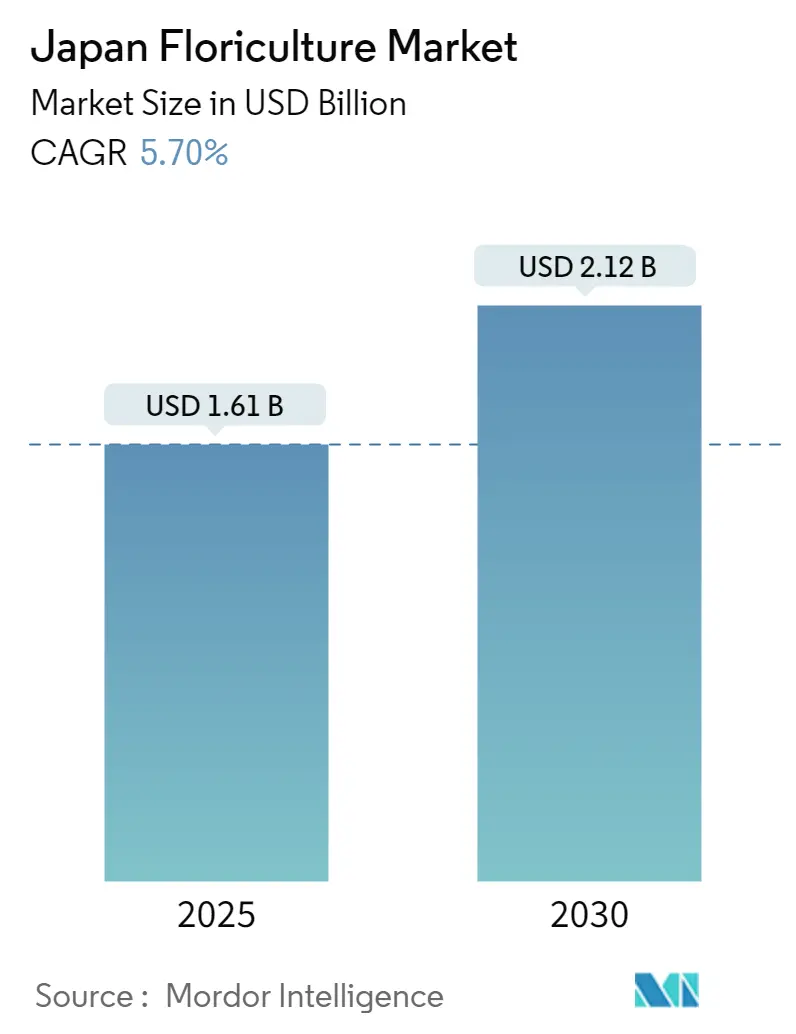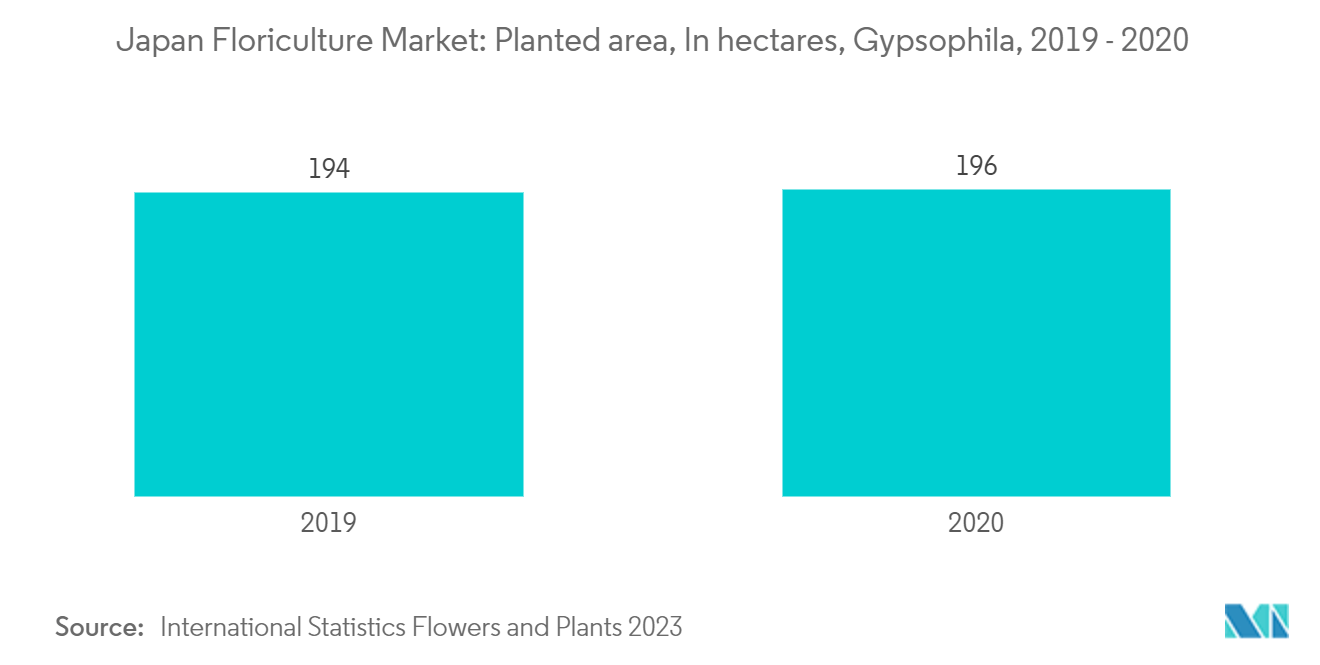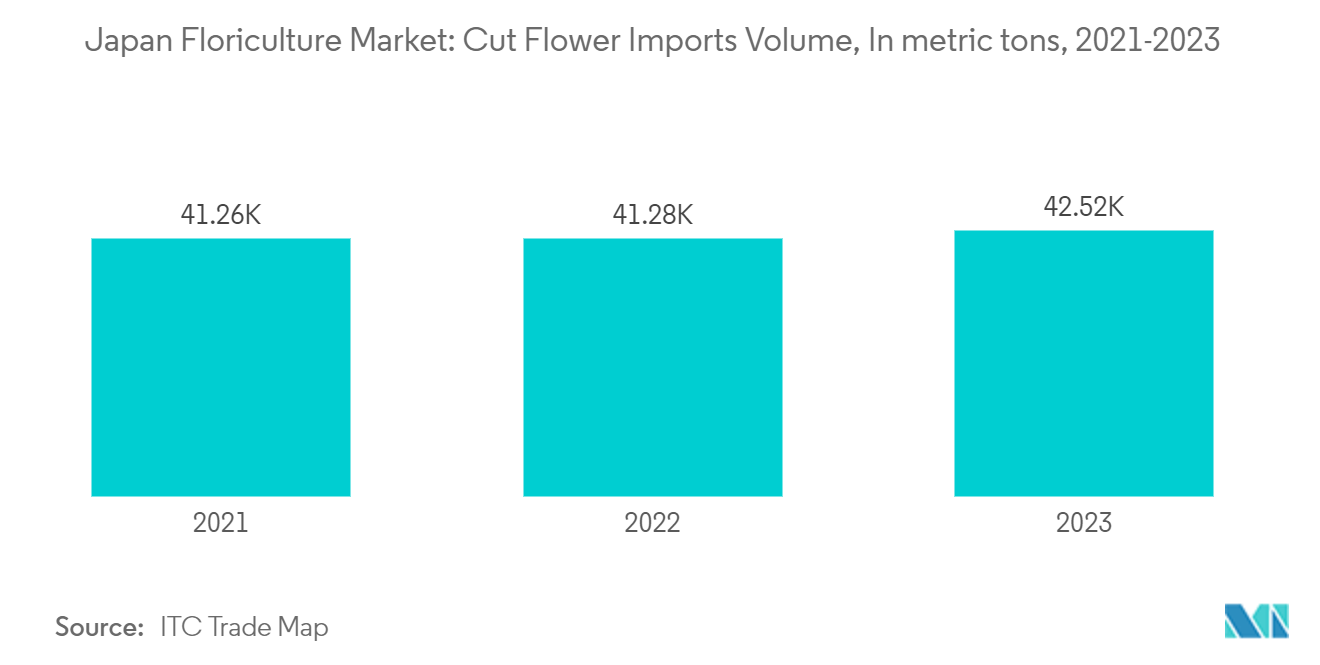
Japan Floriculture Market Analysis by Mordor Intelligence
The Japan Floriculture Market size is estimated at USD 1.61 billion in 2025, and is expected to reach USD 2.12 billion by 2030, at a CAGR of 5.7% during the forecast period (2025-2030).
- The Japanese floriculture market is vibrant and dynamic, renowned for its high-quality flowers, innovative arrangements, and cultural significance. It is characterized by a diverse range of players, including domestic producers, importers, wholesalers, and retailers. Popular flowers in Japan include chrysanthemums, lilies, roses (bara), orchids, and carnations, often used in traditional arrangements and ikebana. In July 2024, the country saw the rare bloom of the "Century Plant" for the first time in a century. Events like these drive the market's expansion.
- Flowers hold significant cultural importance in Japan, symbolizing beauty, purity, and respect. For example, the cherry blossom, or sakura, serves as Japan's emblem. It embodies beauty, sweetness, and gentleness, with its fleeting lifespan symbolizing the transient essence of beauty. Cherry blossoms are used in various ceremonies, festivals, and everyday life. The market has witnessed notable trends, such as the growing popularity of imported flowers, the emergence of young online florists, and the increased demand for sustainable and locally grown flowers. According to the ITC Trade Map, in 2023, Japan imported 23,194 metric tons of cut chrysanthemum flowers, 7.1% more than the previous year.
- Despite facing challenges like rising costs and competition from imported flowers, the Japanese floriculture market continues to evolve and adapt. Innovations in cultivation techniques, packaging, and marketing have helped to sustain its growth. Additionally, the market's focus on quality, craftsmanship, and cultural significance has contributed to its enduring appeal.
Japan Floriculture Market Trends and Insights
Demographic Shift in Farmers Engaged in Floriculture
- Japan is a global frontrunner in flower production, with over 3,000 farms dotting its landscape. While the nation witnesses a decline in domestic and commercial farms predominantly managed by elderly households, a notable surge in young farmers embracing flower cultivation is evident. Notably, individuals under 45 years of age engaged in flower production outnumber their counterparts in flower farming by nearly double.
- The floriculture market in Japan holds immense promise, offering lucrative employment opportunities for the nation's youth. This profitability is not only fueling market expansion but also attracting younger generations. Moreover, with flower farming being perceived as an enjoyable recreational pursuit, young cultivators are diversifying into various flower species, particularly those with lucrative export potential. Data from the World Fact Book highlighted Japan's median age at approximately 49.9 years in 2024. This demographic insight underscored the active participation of younger individuals in the floriculture market, a trend poised to significantly bolster the domestic market.
- Private enterprises and emerging young growers predominantly breed most plant and flower varieties. This dynamic is set to enhance crop productivity, further propelling Japan's floriculture market. Notably, energy-efficient technologies are being harnessed in flower production, with post-sundown heating and lighting cutting energy consumption by a commendable 30%. Such innovations, embraced by the younger generation, are not only expanding the cultivation area for primary flower varieties but also boosting overall productivity. Data from the Statistics Bureau of Japan revealed a rise in the planted area for Gypsophila, from 194 hectares in 2019 to 196 hectares in 2020. This adeptness with production technologies among young farmers underscores their pivotal role in the market's upward trajectory.

Cut Flowers Dominate the Market
- In Japan, cut flowers dominate the cultivated landscape, followed closely by potted flowers and bulbous plants. The robust production of these floriculture products is underscored by strong export values, a testament to their quality. For instance, data from the ITC Trade Map revealed that in 2023, the export value of cut flowers reached USD 12,184, marking a 5% increase from the USD 11,599 recorded the previous year.
- Aichi, Okinawa, and Shizuoka are the leading prefectures in terms of flower and plant cultivation areas. When it comes to output and sales, Aichi, Chiba, and Fukuoka dominate, collectively representing about 31.0% of the nation's agricultural production in this market. As per data from International Statistics Flowers and Plants 2023, Japan's per capita consumption of cut flowers stands at EUR 26 (USD 27.3) in 2022.
- Chrysanthemums are Japan's most favored cut flower. International Statistics Flowers and Plants 2023 data highlighted that in 2020, Japan shipped a staggering 1.3 billion stalks of chrysanthemums, leading the pack, followed by carnations and roses. However, a market supply shortfall heightened the nation's reliance on imports to satiate consumer demand. This burgeoning appetite for fresh-cut flowers also spurred increased exports from neighboring countries.
- Data from the ITC Trade Map indicated that Japan imported 41,282 metric tons of cut flowers in 2022, which increased to 42,524 metric tons in 2023. Key suppliers included China, Malaysia, Vietnam, and Colombia. Such high demand and subsequent imports have solidified cut flowers as a pivotal segment driving the market's growth.

Recent Industry Developments
- April 2024: Schoneveld Breeding's 'Illusia' flowering pot plant clinched the prestigious Japan Flower of the Year 2023-2024 award. Renowned for its upward-blooming and long-lasting flowers, 'Illusia' garnered accolades for its distinctive allure. This accolade not only highlights 'Illusia's' appeal but also signals its bright prospects in the Japanese market and beyond.
- January 2023: Suntory Flowers inaugurated a cutting-edge research facility in Higashi Omi, Shiga Prefecture, Japan, focusing on developing new flower varieties and boosting production within controlled greenhouse environments.
Japan Floriculture Market Report Scope
Floriculture is a horticulture practice focusing on the cultivation of flowering and ornamental plants for garden and commercial use.
The Japanese floriculture market is segmented by type of flowers (cut flowers, bulbous plants, and potted flowers). The report includes value chain analysis and trade analysis (import by value and volume and export analysis by value and volume). The report offers market sizes and forecasts in terms of value (USD) and volume (metric tons) for all the above segments.
| Cut Flowers | Carnation |
| Rose | |
| Chrysanthemum | |
| Lily | |
| Orchid | |
| Other Types of Flowers | |
| Bulbous Plants | |
| Potted Flowers |
| Type of Flowers | Cut Flowers | Carnation |
| Rose | ||
| Chrysanthemum | ||
| Lily | ||
| Orchid | ||
| Other Types of Flowers | ||
| Bulbous Plants | ||
| Potted Flowers |
Key Questions Answered in the Report
How big is the Japan Floriculture Market?
The Japan Floriculture Market size is expected to reach USD 1.61 billion in 2025 and grow at a CAGR of 5.70% to reach USD 2.12 billion by 2030.
What is the current Japan Floriculture Market size?
In 2025, the Japan Floriculture Market size is expected to reach USD 1.61 billion.
What years does this Japan Floriculture Market cover, and what was the market size in 2024?
In 2024, the Japan Floriculture Market size was estimated at USD 1.52 billion. The report covers the Japan Floriculture Market historical market size for years: 2019, 2020, 2021, 2022, 2023 and 2024. The report also forecasts the Japan Floriculture Market size for years: 2025, 2026, 2027, 2028, 2029 and 2030.
Page last updated on:
Japan Floriculture Market Report
Statistics for the 2025 Japan Floriculture market share, size and revenue growth rate, created by Mordor Intelligence™ Industry Reports. Japan Floriculture analysis includes a market forecast outlook for 2025 to 2030 and historical overview. Get a sample of this industry analysis as a free report PDF download.

